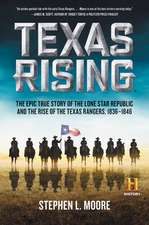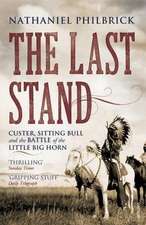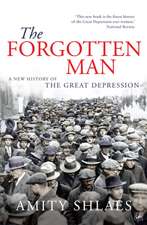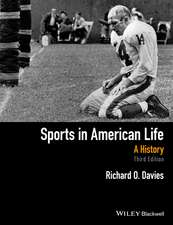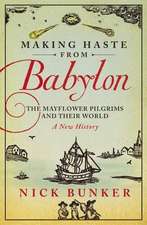Jesse James: Last Rebel of the Civil War
Autor T J Stilesen Limba Engleză Paperback – 30 sep 2003
Vezi toate premiile Carte premiată
Raised in a fiercely pro-slavery household in bitterly divided Misssouri, at age sixteen James became a bushwhacker, one of the savage Confederate guerrillas that terrorized the border states. After the end of the war, James continued his campaign of robbery and murder into the brutal era of reconstruction, when his reckless daring, his partisan pronouncements, and his alliance with the sympathetic editor John Newman Edwards placed him squarely at the forefront of the former Confederates’ bid to recapture political power. With meticulous research and vivid accounts of the dramatic adventures of the famous gunman, T. J. Stiles shows how he resembles not the apolitical hero of legend, but rather a figure ready to use violence to command attention for a political cause—in many ways, a forerunner of the modern terrorist.
Preț: 114.68 lei
Nou
Puncte Express: 172
Preț estimativ în valută:
21.95€ • 23.83$ • 18.44£
21.95€ • 23.83$ • 18.44£
Carte indisponibilă temporar
Doresc să fiu notificat când acest titlu va fi disponibil:
Se trimite...
Preluare comenzi: 021 569.72.76
Specificații
ISBN-13: 9780375705588
ISBN-10: 0375705589
Pagini: 544
Ilustrații: 16 PAGES B&W ILLUS./6 MAPS
Dimensiuni: 125 x 210 x 30 mm
Greutate: 0.54 kg
Ediția:Vintage Books
Editura: Vintage Publishing
ISBN-10: 0375705589
Pagini: 544
Ilustrații: 16 PAGES B&W ILLUS./6 MAPS
Dimensiuni: 125 x 210 x 30 mm
Greutate: 0.54 kg
Ediția:Vintage Books
Editura: Vintage Publishing
Notă biografică
A native of rural Benton County, Minnesota, T.J. Stiles studied history at Carleton College and Columbia University, where he received two graduate degrees. His writings about American history include articles in Smithsonian, essays in the Los Angeles Times and the Denver Post, and a five-volume series of primary-source anthologies. He lives in New York. For more information on T. J. Stiles and Jesse James see www.tjstiles.com.
Extras
Part One
Zion
1842-1860
Walk about Zion, and go round about her; tell the towers thereof. Mark ye well her bulwarks, consider her palaces, that ye may tell it to the generation following.
-Psalms 48:12-13
Chapter One - The Preacher
In the blind man's memory, the river ran west. It was in the spring of 1846 when young Francis Parkman had first looked on the Missouri, and he had seen clearly that its wide and silty waters flowed east to the Mississippi. But when he closed his faltering eyes in a clinic on Staten Island in 1847 and began to dictate the story of his adventure of the previous year, he had already begun to think like the great historian he would soon become. As he scanned in his mind the lines of passengers and clots of wagons and piles of goods crowding the St. Louis levee, as he recalled the sound of steamboat paddles slapping and churning against the Missouri's current, he could see the life of the nation pulsing westward up the river like blood cells pouring through an artery. In the most important sense, the river ran west.1
Parkman did not record how he arrived in St. Louis from his home in Boston, but he undoubtedly spent most of his trip on the water. It was virtually his only choice. Most roads amounted to little more than muddy ravines-in Missouri, it was said that roads were worn, not made-and the first, pioneering railways had yet to cover much territory. So, whenever possible, Americans set out in schooners and square-rigged ships, paddlewheel steamboats, or mule-drawn canal barges. He might have taken a ship to New Orleans, then a riverboat north; or he could have sailed up the Hudson, been towed down the Erie Canal, then shipped through the Great Lakes before crossing to descend the Mississippi, or taking another canal to reach the mighty Ohio.2
North and south, east and west, these flowing highways met at the metropolis of St. Louis. One of Parkman's contemporaries, a farm woman named Elizabeth Carter, wrote that merchants swarmed in and out of the place "like bees." The water off the city's tightly packed levee presented a breathtaking spectacle, as dozens of teetering, wedding-cake paddlewheelers pressed in to find a landing. "The steamboats were strung up and down the river for miles as close as they could stand," she wrote to her family in Kentucky.3
Some fifty of those vessels regularly plied the Missouri River, hauling passengers and goods between St. Louis and the state's inner river towns. But the twenty-two-year-old Parkman's imagination was captured by the immense throng of settlers and traders bound for Oregon, California, and Santa Fe. "The hotels were crowded," he wrote, "and the gunsmiths and saddlers were kept constantly at work in providing arms and equipments for the different parties of travellers."4
On April 28, 1846, Parkman left St. Louis on a Missouri steamer named the Radnor. "The boat was loaded until the water broke alternately over the guards," he recalled. "Her upper-deck was covered with large wagons of a peculiar form, for the Santa Fe trade, and her hold was crammed with goods for the same destination. There were also equipments and provisions of a party of Oregon emigrants, a band of mules and horses, piles of saddles and harness."
For the next week, the heavily laden steamboat chugged up the winding river, forcing its way against the swift current. The Missouri ran high in the spring, making the pilot's job simpler-but not simple. The channel constantly shifted back and forth across the soft-soiled floodplain; sandbars swelled into islands and then dissolved; snags of drifting dead trees came and went, threatening to spear the hull of a poorly guided boat. Everything rested on the pilot's knowledge and skill. He had to learn and relearn the river, read the water for shoals and snags, know how to time a burst of steam to carry the boat through a shallow chute. It was a dangerous career. Between boiler explosions and the river's own obstacles, an average of three boats each year sank to the Missouri's muddy bottom, often taking dozens of lives at a time. The pilot, Mark Twain later wrote, ruled over his vessel "in glory," trumping even the captain in pay and authority.5
During that week, the Radnor existed as a floating town, piled high and trailing a cloud of smoke. The average boat was a sidewheeler, some 165 feet long and 28 feet wide-though they often reached 250 feet with a 40-foot beam-and some could hold as many as 400 passengers. "In her cabin were Santa Fe traders, gamblers, speculators, and adventurers of various descriptions," Parkman observed, "and her steerage was crowded with Oregon emigrants, 'mountain men,' negroes, and a party of Kanzas Indians, who had been on a visit to St. Louis." Also on board, unmentioned by the young Bostonian, would have been country lawyers, frontier merchants, and farmers returning home, along with dozens of women, children, and teenagers. "The young people seemed to enjoy themselves very well," Elizabeth Carter noted on a similar trip, "with music and dancing every night."6
"In five or six days we began to see signs of the great western movement that was then taking place," Parkman recalled. Tents and wagons began to appear on the bank as the boat drew near Independence. When the Radnor steamed in to the landing, he gaped at the wild diversity of the scene: dozens of Mexicans, "gazing stupidly out from beneath their broad hats"; clusters of Native Americans, gathered silently around campfires; a few long-haired, buckskin-clad French hunters, fresh from the mountains; and crowds of Anglo-Saxon pioneers.7
There was probably no other place in the country like Missouri's western border. The aptly named town of Westport served as the access point between the settled states and the Great Plains, the Rocky Mountains, and the Pacific coast. Traders came and went, spending the Spanish silver coins they acquired in Santa Fe; Native Americans of countless nations and cultures visited and passed through; and settlers departed by the thousands in their ox-drawn wagons. The first large group of emigrants had departed for Oregon just three years before, starting a steady flow to that distant territory; and now the Mormons were gathering for a long trek west that would end at Great Salt Lake, deep in Mexican territory. Westport's shops were filled with the sounds of English, Spanish, French, along with the occasional German and various Indian languages.
And yet, as wild as the region might have seemed to the eye, it was hardly a raw, untamed frontier. A full decade before Parkman's arrival, one writer thought that many of the towns "would lead the visitor to believe, were he governed by appearances, that he was in the heart of the best settlements of one of the older states." A few years afterward, another visitor made a telling observation: Missouri's western border, he wrote, "is fenced up all on one side with old and well improved farms as far east as we could see, while on the right . . . it is open, wild prairie."8
Hard against this boundary-next to the vast plains that President Andrew Jackson had set aside as the "permanent Indian frontier"-sat this long-settled, thriving community, bustling with commerce. Hemp and tobacco fields abounded; river towns rang with noise from carriage workshops, tobacco stemmeries, and leaf-prizing houses, as well as ropewalks, where hemp's rough fibers were turned into twine. Both farmers and merchants prospered by selling supplies to the migrants marching by. Passing wagon trains kept cobblers, saddle makers, and blacksmiths busy; they also provided a major market for locally raised food and livestock. In May 1848, for example, outfitter Edward M. Samuel in the town of Liberty announced that he needed at least two thousand pounds of bacon to keep up with demand.9
When Parkman looked over these Missourians, he found them "yellow-visaged," with "lank angular proportions, enveloped in brown homespun, evidently cut and adjusted by the hands of a domestic female tailor." Though his description seems at odds with this general picture of prosperity, it was nonetheless accurate. Almost everything had a handmade look out here, on the far end of the bending limb of the Missouri River. "From all I have seen," Elizabeth Carter wrote from Clay County, "I would judge that the people are very plain." Even residents whose homes dated back to the early 1820s sometimes lived in log cabins, though well-improved ones; many used walnut or butternut oil to die their homespun clothes a distinctive brown, earning these people the nickname "butternuts."10
Butternuts could be found all across Missouri, Illinois, Indiana, and Ohio, where they had moved from the upper South-especially from Kentucky, the great fountain of settlers that flooded the Ohio and Mississippi valleys in the early nineteenth century. They went by other nicknames as well, such as crackers, hoosiers, pukes, and rednecks-terms that originated in Ulster, Scotland, and northern England, where this long movement of peoples began a century earlier. Even the wealthiest among them-those who could afford fine wool and cotton clothes, rather than walnut-stained homespun-shared common cultural traits: a willingness to resort to violence, for example, to resolve private disputes or keep public order.11
Parkman continued on into the vast expanse of the Great Plains, where he joined a wandering Oglala band of the Lakota people; but when he turned in his saddle to glance over his shoulder, settled Missouri itself looked like an alien land to his Harvard-bred, Bostonian eyes. How different it must have seemed to another passenger who stepped off a steamboat that spring; to him, Missouri's western reaches would have been little less than Zion.
This man had also spent a slow week in early 1846 on a paddlewheeler from St. Louis, as it churned toward the setting sun. If he had been aboard the Radnor, Parkman would have noticed him: he was a commanding figure, a tall man with a long, thin face, his hair parted on one side and combed across to leave his high forehead bare. Perhaps he carried a Bible when he appeared in the dining room for his meals; though his name was Robert Sallee James, this twenty-eight-year-old was better known to his Baptist neighbors as brother or Preacher James.12
He probably disembarked at Liberty landing, in Clay County, across the river from Independence. There he would have hired a horse or a wagon for the long ride home along those rutted tracks that Missourians called roads, across a landscape that resembled a rug pushed into a corner: rumpled, wrinkled, rippled with ravines and dusted with timber. His route would have carried him through the town of Liberty, the prosperous but modest county seat, and a dozen miles farther into the northern reaches of Clay. There he would have ridden over a low rise and caught sight of a humble three-room house with a narrow porch stretching across its single story, perched with a barn and a few outbuildings above a deep streambed. It was home.13
James had clearly given careful thought to the timing of the extended trip he had just completed. The month of January, though the deepest trough of winter, overflowed with labor for the typical Missouri farmer, but eight to twelve weeks into the year the demands temporarily lightened. The river, too, would finally be free of ice, as the first paddlewheelers puffed into the landings along Clay County's long waterfront. After selling his annual harvest of hemp, he would have had several weeks free before new seed had to go into the ground. So church member Jane W. Gill expressed little surprise when she noted in a letter that "Preacher James" had departed in late March to visit his native Kentucky.14
But there was something odd about that journey. He apparently went alone, leaving behind his wife of five years, Zerelda Cole James, and their two-year-old son. Robert looked uncertain and uneasy when he left, a condition that his neighbors kept in mind as they welcomed him home. "Preacher James," Gill wrote on June 15, 1846, "was here with his wife a few days after his return, and seems better contented to live in Mo."15
Better contented. These modest words suggest a disquiet not quite dispelled. But the cause of his discontent is unclear. By any measure, he had already come far from his humble beginnings. Born on July 7, 1818, he became an orphan at the age of nine and went to live with his sister Mary Mimms (eighteen years old and already married). In 1838, he enrolled at Georgetown College, Kentucky, a rare distinction at a time when primary education was haphazard, secondary education rare, and illiteracy all too common. There he met Zerelda E. Cole, a strikingly tall girl who attended a Roman Catholic school in town. And she was indeed a girl. Born on January 29, 1825, she was only sixteen when she engaged to marry the devout college student.16
Zerelda, too, was a native of Kentucky, and she, too, had lost a parent at an early age. Her father had died when she was just two, and she was left by her mother with her grandfather, Robert Cole. After he died, her mother married Robert Thomason-reportedly ignoring Zerelda's disapproval-and moved to distant Clay County, Missouri. Once again, the girl found herself packed off to live with relatives, this time with her uncle James M. Lindsay in Scott County, Kentucky. Though a Protestant, she entered the Catholic school in Georgetown, the community where she met her future husband. On December 20, 1841, they said their vows at Lindsay's home. The wedding of such a young girl was not an ordinary event in antebellum Kentucky: Lindsay had to give county officials his written permission for the minor to marry. Once Robert James received his diploma, in the spring of 1842, the pair packed their things and traveled to Clay County, where they moved in with Zerelda's mother and Thomason. The child bride soon showed signs of pregnancy. Nine days before her eighteenth birthday, on January 10, 1843, she delivered a boy. They named him Alexander Franklin James, or Frank, for short.17
All in all, Robert James found himself in a seemingly blissful domestic setting, with a young, attractive wife and a newborn son. But he was a restless, driven man. In short order, he found a forum for his ambition at the New Hope Baptist Church. Founded in 1828, it was a humble affair: a log structure twenty feet square, with a haphazard stone chimney that opened into a gaping fireplace. Even in this cramped space, worshippers had plenty of room during Sunday meetings. Their recently departed preacher had driven away most members with heated doctrinal disputes over communion. When James first arrived, a mere fifteen people gathered for services.18
In that dim, gritty church, James discovered his own inner light; and in him, the tiny church found its salvation, in both the spiritual and the worldly sense. Baptist congregations ordained their own preachers from among their membership; nothing more was required than a mutual agreement that a man had received a divine calling to speak the word of God. And the pious, charismatic, well-educated young fellow from Kentucky inspired immediate consensus among these "very plain" people. One neighbor recalled how he had attended the ordination service as a boy.
From the Hardcover edition.
Zion
1842-1860
Walk about Zion, and go round about her; tell the towers thereof. Mark ye well her bulwarks, consider her palaces, that ye may tell it to the generation following.
-Psalms 48:12-13
Chapter One - The Preacher
In the blind man's memory, the river ran west. It was in the spring of 1846 when young Francis Parkman had first looked on the Missouri, and he had seen clearly that its wide and silty waters flowed east to the Mississippi. But when he closed his faltering eyes in a clinic on Staten Island in 1847 and began to dictate the story of his adventure of the previous year, he had already begun to think like the great historian he would soon become. As he scanned in his mind the lines of passengers and clots of wagons and piles of goods crowding the St. Louis levee, as he recalled the sound of steamboat paddles slapping and churning against the Missouri's current, he could see the life of the nation pulsing westward up the river like blood cells pouring through an artery. In the most important sense, the river ran west.1
Parkman did not record how he arrived in St. Louis from his home in Boston, but he undoubtedly spent most of his trip on the water. It was virtually his only choice. Most roads amounted to little more than muddy ravines-in Missouri, it was said that roads were worn, not made-and the first, pioneering railways had yet to cover much territory. So, whenever possible, Americans set out in schooners and square-rigged ships, paddlewheel steamboats, or mule-drawn canal barges. He might have taken a ship to New Orleans, then a riverboat north; or he could have sailed up the Hudson, been towed down the Erie Canal, then shipped through the Great Lakes before crossing to descend the Mississippi, or taking another canal to reach the mighty Ohio.2
North and south, east and west, these flowing highways met at the metropolis of St. Louis. One of Parkman's contemporaries, a farm woman named Elizabeth Carter, wrote that merchants swarmed in and out of the place "like bees." The water off the city's tightly packed levee presented a breathtaking spectacle, as dozens of teetering, wedding-cake paddlewheelers pressed in to find a landing. "The steamboats were strung up and down the river for miles as close as they could stand," she wrote to her family in Kentucky.3
Some fifty of those vessels regularly plied the Missouri River, hauling passengers and goods between St. Louis and the state's inner river towns. But the twenty-two-year-old Parkman's imagination was captured by the immense throng of settlers and traders bound for Oregon, California, and Santa Fe. "The hotels were crowded," he wrote, "and the gunsmiths and saddlers were kept constantly at work in providing arms and equipments for the different parties of travellers."4
On April 28, 1846, Parkman left St. Louis on a Missouri steamer named the Radnor. "The boat was loaded until the water broke alternately over the guards," he recalled. "Her upper-deck was covered with large wagons of a peculiar form, for the Santa Fe trade, and her hold was crammed with goods for the same destination. There were also equipments and provisions of a party of Oregon emigrants, a band of mules and horses, piles of saddles and harness."
For the next week, the heavily laden steamboat chugged up the winding river, forcing its way against the swift current. The Missouri ran high in the spring, making the pilot's job simpler-but not simple. The channel constantly shifted back and forth across the soft-soiled floodplain; sandbars swelled into islands and then dissolved; snags of drifting dead trees came and went, threatening to spear the hull of a poorly guided boat. Everything rested on the pilot's knowledge and skill. He had to learn and relearn the river, read the water for shoals and snags, know how to time a burst of steam to carry the boat through a shallow chute. It was a dangerous career. Between boiler explosions and the river's own obstacles, an average of three boats each year sank to the Missouri's muddy bottom, often taking dozens of lives at a time. The pilot, Mark Twain later wrote, ruled over his vessel "in glory," trumping even the captain in pay and authority.5
During that week, the Radnor existed as a floating town, piled high and trailing a cloud of smoke. The average boat was a sidewheeler, some 165 feet long and 28 feet wide-though they often reached 250 feet with a 40-foot beam-and some could hold as many as 400 passengers. "In her cabin were Santa Fe traders, gamblers, speculators, and adventurers of various descriptions," Parkman observed, "and her steerage was crowded with Oregon emigrants, 'mountain men,' negroes, and a party of Kanzas Indians, who had been on a visit to St. Louis." Also on board, unmentioned by the young Bostonian, would have been country lawyers, frontier merchants, and farmers returning home, along with dozens of women, children, and teenagers. "The young people seemed to enjoy themselves very well," Elizabeth Carter noted on a similar trip, "with music and dancing every night."6
"In five or six days we began to see signs of the great western movement that was then taking place," Parkman recalled. Tents and wagons began to appear on the bank as the boat drew near Independence. When the Radnor steamed in to the landing, he gaped at the wild diversity of the scene: dozens of Mexicans, "gazing stupidly out from beneath their broad hats"; clusters of Native Americans, gathered silently around campfires; a few long-haired, buckskin-clad French hunters, fresh from the mountains; and crowds of Anglo-Saxon pioneers.7
There was probably no other place in the country like Missouri's western border. The aptly named town of Westport served as the access point between the settled states and the Great Plains, the Rocky Mountains, and the Pacific coast. Traders came and went, spending the Spanish silver coins they acquired in Santa Fe; Native Americans of countless nations and cultures visited and passed through; and settlers departed by the thousands in their ox-drawn wagons. The first large group of emigrants had departed for Oregon just three years before, starting a steady flow to that distant territory; and now the Mormons were gathering for a long trek west that would end at Great Salt Lake, deep in Mexican territory. Westport's shops were filled with the sounds of English, Spanish, French, along with the occasional German and various Indian languages.
And yet, as wild as the region might have seemed to the eye, it was hardly a raw, untamed frontier. A full decade before Parkman's arrival, one writer thought that many of the towns "would lead the visitor to believe, were he governed by appearances, that he was in the heart of the best settlements of one of the older states." A few years afterward, another visitor made a telling observation: Missouri's western border, he wrote, "is fenced up all on one side with old and well improved farms as far east as we could see, while on the right . . . it is open, wild prairie."8
Hard against this boundary-next to the vast plains that President Andrew Jackson had set aside as the "permanent Indian frontier"-sat this long-settled, thriving community, bustling with commerce. Hemp and tobacco fields abounded; river towns rang with noise from carriage workshops, tobacco stemmeries, and leaf-prizing houses, as well as ropewalks, where hemp's rough fibers were turned into twine. Both farmers and merchants prospered by selling supplies to the migrants marching by. Passing wagon trains kept cobblers, saddle makers, and blacksmiths busy; they also provided a major market for locally raised food and livestock. In May 1848, for example, outfitter Edward M. Samuel in the town of Liberty announced that he needed at least two thousand pounds of bacon to keep up with demand.9
When Parkman looked over these Missourians, he found them "yellow-visaged," with "lank angular proportions, enveloped in brown homespun, evidently cut and adjusted by the hands of a domestic female tailor." Though his description seems at odds with this general picture of prosperity, it was nonetheless accurate. Almost everything had a handmade look out here, on the far end of the bending limb of the Missouri River. "From all I have seen," Elizabeth Carter wrote from Clay County, "I would judge that the people are very plain." Even residents whose homes dated back to the early 1820s sometimes lived in log cabins, though well-improved ones; many used walnut or butternut oil to die their homespun clothes a distinctive brown, earning these people the nickname "butternuts."10
Butternuts could be found all across Missouri, Illinois, Indiana, and Ohio, where they had moved from the upper South-especially from Kentucky, the great fountain of settlers that flooded the Ohio and Mississippi valleys in the early nineteenth century. They went by other nicknames as well, such as crackers, hoosiers, pukes, and rednecks-terms that originated in Ulster, Scotland, and northern England, where this long movement of peoples began a century earlier. Even the wealthiest among them-those who could afford fine wool and cotton clothes, rather than walnut-stained homespun-shared common cultural traits: a willingness to resort to violence, for example, to resolve private disputes or keep public order.11
Parkman continued on into the vast expanse of the Great Plains, where he joined a wandering Oglala band of the Lakota people; but when he turned in his saddle to glance over his shoulder, settled Missouri itself looked like an alien land to his Harvard-bred, Bostonian eyes. How different it must have seemed to another passenger who stepped off a steamboat that spring; to him, Missouri's western reaches would have been little less than Zion.
This man had also spent a slow week in early 1846 on a paddlewheeler from St. Louis, as it churned toward the setting sun. If he had been aboard the Radnor, Parkman would have noticed him: he was a commanding figure, a tall man with a long, thin face, his hair parted on one side and combed across to leave his high forehead bare. Perhaps he carried a Bible when he appeared in the dining room for his meals; though his name was Robert Sallee James, this twenty-eight-year-old was better known to his Baptist neighbors as brother or Preacher James.12
He probably disembarked at Liberty landing, in Clay County, across the river from Independence. There he would have hired a horse or a wagon for the long ride home along those rutted tracks that Missourians called roads, across a landscape that resembled a rug pushed into a corner: rumpled, wrinkled, rippled with ravines and dusted with timber. His route would have carried him through the town of Liberty, the prosperous but modest county seat, and a dozen miles farther into the northern reaches of Clay. There he would have ridden over a low rise and caught sight of a humble three-room house with a narrow porch stretching across its single story, perched with a barn and a few outbuildings above a deep streambed. It was home.13
James had clearly given careful thought to the timing of the extended trip he had just completed. The month of January, though the deepest trough of winter, overflowed with labor for the typical Missouri farmer, but eight to twelve weeks into the year the demands temporarily lightened. The river, too, would finally be free of ice, as the first paddlewheelers puffed into the landings along Clay County's long waterfront. After selling his annual harvest of hemp, he would have had several weeks free before new seed had to go into the ground. So church member Jane W. Gill expressed little surprise when she noted in a letter that "Preacher James" had departed in late March to visit his native Kentucky.14
But there was something odd about that journey. He apparently went alone, leaving behind his wife of five years, Zerelda Cole James, and their two-year-old son. Robert looked uncertain and uneasy when he left, a condition that his neighbors kept in mind as they welcomed him home. "Preacher James," Gill wrote on June 15, 1846, "was here with his wife a few days after his return, and seems better contented to live in Mo."15
Better contented. These modest words suggest a disquiet not quite dispelled. But the cause of his discontent is unclear. By any measure, he had already come far from his humble beginnings. Born on July 7, 1818, he became an orphan at the age of nine and went to live with his sister Mary Mimms (eighteen years old and already married). In 1838, he enrolled at Georgetown College, Kentucky, a rare distinction at a time when primary education was haphazard, secondary education rare, and illiteracy all too common. There he met Zerelda E. Cole, a strikingly tall girl who attended a Roman Catholic school in town. And she was indeed a girl. Born on January 29, 1825, she was only sixteen when she engaged to marry the devout college student.16
Zerelda, too, was a native of Kentucky, and she, too, had lost a parent at an early age. Her father had died when she was just two, and she was left by her mother with her grandfather, Robert Cole. After he died, her mother married Robert Thomason-reportedly ignoring Zerelda's disapproval-and moved to distant Clay County, Missouri. Once again, the girl found herself packed off to live with relatives, this time with her uncle James M. Lindsay in Scott County, Kentucky. Though a Protestant, she entered the Catholic school in Georgetown, the community where she met her future husband. On December 20, 1841, they said their vows at Lindsay's home. The wedding of such a young girl was not an ordinary event in antebellum Kentucky: Lindsay had to give county officials his written permission for the minor to marry. Once Robert James received his diploma, in the spring of 1842, the pair packed their things and traveled to Clay County, where they moved in with Zerelda's mother and Thomason. The child bride soon showed signs of pregnancy. Nine days before her eighteenth birthday, on January 10, 1843, she delivered a boy. They named him Alexander Franklin James, or Frank, for short.17
All in all, Robert James found himself in a seemingly blissful domestic setting, with a young, attractive wife and a newborn son. But he was a restless, driven man. In short order, he found a forum for his ambition at the New Hope Baptist Church. Founded in 1828, it was a humble affair: a log structure twenty feet square, with a haphazard stone chimney that opened into a gaping fireplace. Even in this cramped space, worshippers had plenty of room during Sunday meetings. Their recently departed preacher had driven away most members with heated doctrinal disputes over communion. When James first arrived, a mere fifteen people gathered for services.18
In that dim, gritty church, James discovered his own inner light; and in him, the tiny church found its salvation, in both the spiritual and the worldly sense. Baptist congregations ordained their own preachers from among their membership; nothing more was required than a mutual agreement that a man had received a divine calling to speak the word of God. And the pious, charismatic, well-educated young fellow from Kentucky inspired immediate consensus among these "very plain" people. One neighbor recalled how he had attended the ordination service as a boy.
From the Hardcover edition.
Recenzii
"So carefully researched, persuasive, and illuminating that it is likely to reshape permanently our understanding of its subject's life and times." —The New York Times Book Review
"After reading this biography . . . can doubt that the driving force of Jesse James's career was persistent Confederate ideology and loyalty. . . . [Stiles writes] vigorously, eloquently, persuasively." —James M. McPherson, The New York Review of Books
"Intricate, far-reaching. . . . A fascinating revisionist biography.” —TheNew York Times
"In this excellent account, T.J. Stiles shows James to be a southerner, not a westerner; a Confederate, not a cowboy. . . . [He] masterfully strips James bare." —The Economist
“Elegantly rendered and compelling.” —Jay Winik, Washington Post Book World
"Stiles has combed a wealth of contemporary sources and imbues this story with the drama it deserves.” —Eric Foner, Los Angeles Times
“[A] bold, myth-bashing account of the brutal life and times of the outlaw-icon.” —Boston Globe
"Carries the reader scrupulously through James’s violent, violent life. . . . When Stiles, in his subtitle, calls Jesse James the ‘last rebel fo the Civil War; he correctly definies the theme that ruled Jesse’s life." —Larry McMurtry, The New Republic
“A fascinating challnge to old legends.” —The Dallas Morning News
“A dazzling work of American history. . . . James emerges, stripped of his Robin Hood folk mythology, as a more complex and pivotal figure than earlier histories have allowed.” —Sunday Times [London]
“Arresting and powerful.” —The Richmond-Times Dispatch
"This gripping biography of one of the most famous American outlaws clarifies the development of modern violence and proves that the simplistic Jesse James of western movies fall far short of the historical mark." —Milwaukee Journal Sentinel
"Perhaps the finest book ever written about this American legend.” —Salon.com
“The book is quite simply outstanding. . . . [Stiles is] a writer whose allegiance is not with the easy and obvious but with the subtle and definiantly humane.” —Guardian
"As gracefully written as a novel, and convincingly argued throughout, this is biography at its finest." —Bookpage
"Stiles spent four years examining James’s deadliest weapon: his politics. . . . James emerges as no mere robber, but as a proslavery 'terrorist' who remains wildly misunderstood." —Time Out
“In hard-eyed, exhilaratingly physcial language . . . T. J. Stiles takes us beyond the usual interpretation of the outlaw’s notorious life and into a far more challenging understanding of the man.” —The Bloomsbury Review
“Wonderful. . . . An important new biography.” —John Mack Faragher, Raleigh News & Observer
"After reading this biography . . . can doubt that the driving force of Jesse James's career was persistent Confederate ideology and loyalty. . . . [Stiles writes] vigorously, eloquently, persuasively." —James M. McPherson, The New York Review of Books
"Intricate, far-reaching. . . . A fascinating revisionist biography.” —TheNew York Times
"In this excellent account, T.J. Stiles shows James to be a southerner, not a westerner; a Confederate, not a cowboy. . . . [He] masterfully strips James bare." —The Economist
“Elegantly rendered and compelling.” —Jay Winik, Washington Post Book World
"Stiles has combed a wealth of contemporary sources and imbues this story with the drama it deserves.” —Eric Foner, Los Angeles Times
“[A] bold, myth-bashing account of the brutal life and times of the outlaw-icon.” —Boston Globe
"Carries the reader scrupulously through James’s violent, violent life. . . . When Stiles, in his subtitle, calls Jesse James the ‘last rebel fo the Civil War; he correctly definies the theme that ruled Jesse’s life." —Larry McMurtry, The New Republic
“A fascinating challnge to old legends.” —The Dallas Morning News
“A dazzling work of American history. . . . James emerges, stripped of his Robin Hood folk mythology, as a more complex and pivotal figure than earlier histories have allowed.” —Sunday Times [London]
“Arresting and powerful.” —The Richmond-Times Dispatch
"This gripping biography of one of the most famous American outlaws clarifies the development of modern violence and proves that the simplistic Jesse James of western movies fall far short of the historical mark." —Milwaukee Journal Sentinel
"Perhaps the finest book ever written about this American legend.” —Salon.com
“The book is quite simply outstanding. . . . [Stiles is] a writer whose allegiance is not with the easy and obvious but with the subtle and definiantly humane.” —Guardian
"As gracefully written as a novel, and convincingly argued throughout, this is biography at its finest." —Bookpage
"Stiles spent four years examining James’s deadliest weapon: his politics. . . . James emerges as no mere robber, but as a proslavery 'terrorist' who remains wildly misunderstood." —Time Out
“In hard-eyed, exhilaratingly physcial language . . . T. J. Stiles takes us beyond the usual interpretation of the outlaw’s notorious life and into a far more challenging understanding of the man.” —The Bloomsbury Review
“Wonderful. . . . An important new biography.” —John Mack Faragher, Raleigh News & Observer
Descriere
Traditionally, Jesse James has been portrayed as a Wild West bandit--a Robin Hood of sorts--but in this meticulously researched, vividly written account of his life, he emerges as a far more complicated man who was a forerunner of what the world has come to call a terrorist.
Premii
- ALA Notable Books Winner, 2003
- L.A. Times Book Prize Finalist, 2002
- Ambassador Book Awards Winner, 2003


